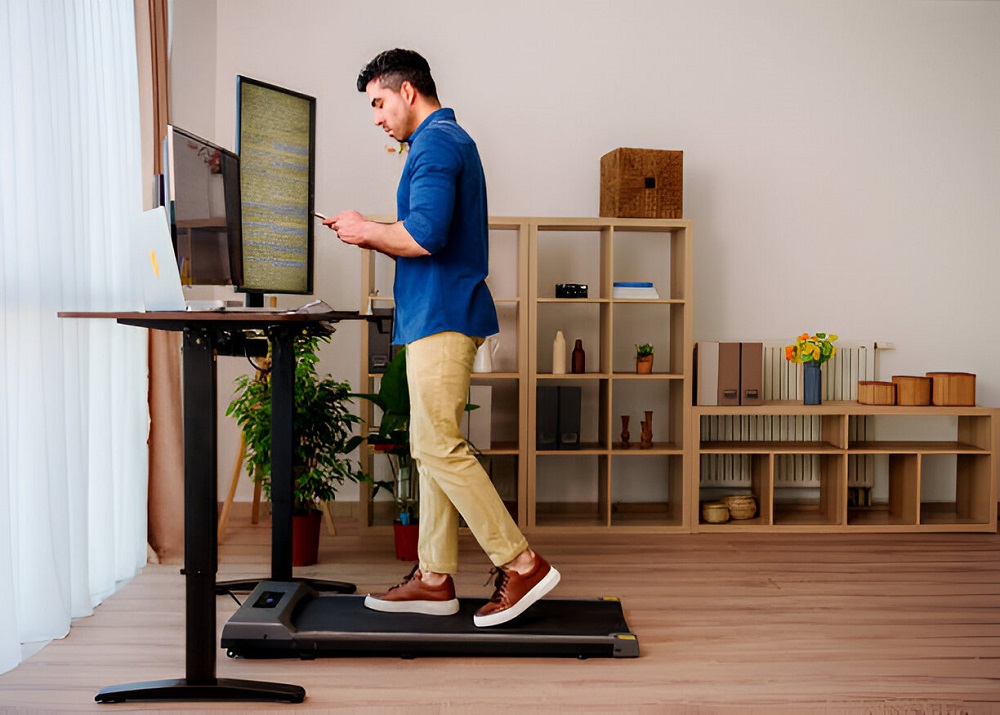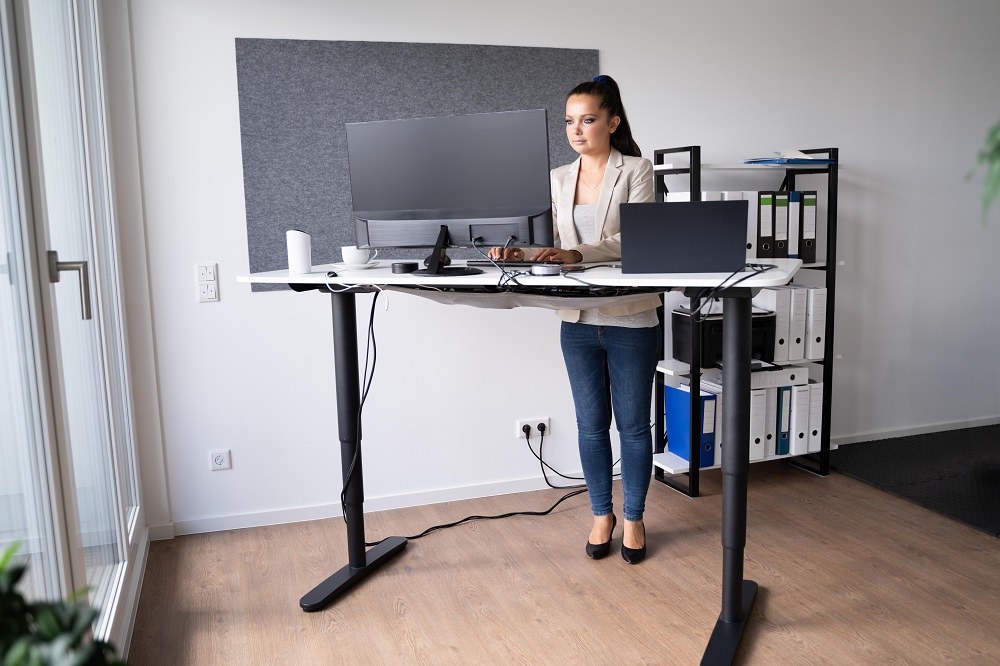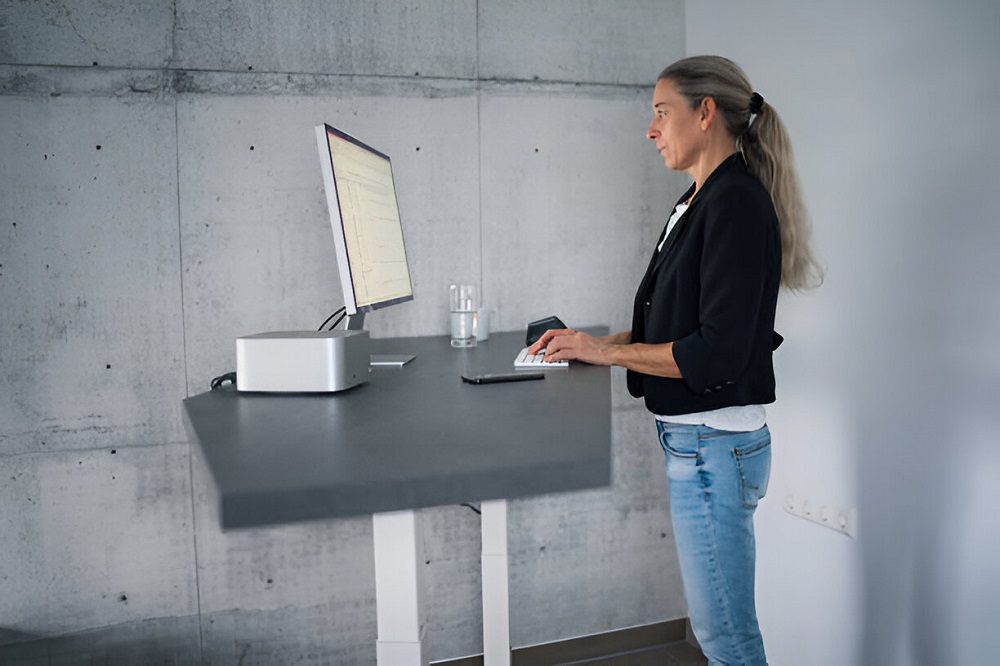Standing desks have become a game-changer in office ergonomics. They offer a multitude of health benefits, promoting better posture, reducing back pain, and even boosting calorie burning throughout the workday.
However, choosing the right standing desk can be an overwhelming task with so many size variations available.
This comprehensive guide will navigate you through what are standing desks, the intricate world of standing desks, and dimensions, ensuring you find the perfect fit for your workspace and work style.
What are Standing Desks?
Traditional desks confine us to a sedentary position for extended periods, leading to various health concerns. On the other hand, standing desks allow you to work comfortably while standing.
They typically feature electrically adjustable legs that raise and lower the desk platform to your desired height. This allows you to alternate between sitting and standing throughout the day, promoting healthier blood flow, increased energy levels, and improved focus.
Standard Desk Size vs. Standing Desk Size
While standard desks typically have a fixed height of around 29 inches, standing desks offer a much wider range of adjustability. However, there are some standard size ranges to consider when it comes to the surface area of both types of desks:
- Standard Desk Size: The standard desk size dimensions for single, fixed-height desks typically range from 36 to 72 inches in width and 24 to 36 inches in depth. Smaller desks (around 36" x 24") cater to minimal setups with just a laptop and basic essentials. Larger desks (around 60" x 30") offer ample space for multiple monitors, keyboards, documents, and other office equipment.
- Standing Desk Size: Standing desks generally come in similar width and depth ranges as standard desks (typically 48" to 72" wide and 24" to 30" deep). However, the key difference lies in their adjustable height mechanism, which allows them to rise to a comfortable standing position (usually between 22.5" to 48.5").

The Top Three Aspects: Length, Width, and Depth Explained
Now, let's delve deeper into the three crucial dimensions that define a standing desk's size:
- Length (typically 48" to 72" and above): This refers to the horizontal span of the desk, essentially the distance from left to right. A longer desk provides more space to spread out with multiple monitors, printers, extensive paperwork, or other equipment you might need for your work.
- Width (typically 24" to 30" and above): This is the side-to-side measurement of the desk. A wider desk offers more elbow room, allowing you to position your arms comfortably while typing or using a mouse. This is particularly important for maintaining proper ergonomics and preventing repetitive strain injuries.
- Depth (typically 24" to 30" and above): This is the front-to-back measurement of the desk. A deeper desk provides more space for your keyboard, mouse, monitor stand, and other peripherals while ensuring you can maintain a proper arm position with good posture.
Choosing Your Ideal Standing Desk Size: A Multi-Factor Approach
The perfect size for your standing desk isn't a one-size-fits-all solution. It depends on a blend of factors specific to your workspace and work style:
- Available Space: Meticulously measure your designated workspace before embarking on your standing desk shopping spree. Consider doorways, walkways, and any existing furniture that might limit your available space. Your standing desk shouldn't feel cramped or restrict your ability to move comfortably around it.
- Number of Monitors: A longer desk (ideally 60 inches or above) is recommended for optimal viewing comfort if you work with multiple monitors. This ensures you can position each monitor comfortably and at an angle without straining your neck or eyes.
- Work Style: Do you frequently spread paperwork, reference documents, or work on large projects requiring ample surface area? To accommodate your workspace needs, opt for a wider and deeper desk (ideally with a depth of 30 inches or more). Conversely, a smaller desk (around 36" length x 24" depth) might suffice if you primarily work on a laptop and require minimal additional space.
- Sharing Your Desk: If you plan on sharing a standing desk with a colleague, consider a larger L-shaped option. This provides designated work areas for each person while maximizing available space.
Alternatively, a wider desk (ideally with a width of 60 inches or more) can also accommodate two workstations, provided there's sufficient space for each person's equipment.
Beyond the Basics: Additional Considerations for Optimal Comfort
- Monitor Arms: Mounting your monitors to the wall or desk using monitor arms is a fantastic space-saving strategy. These arms free up valuable desk space that would otherwise be occupied by monitor stands.
When choosing a desk depth, factor in the reach of the monitor arm to ensure your monitors are positioned at a comfortable viewing distance. - Ergonomic Keyboard Placement: Proper arm and wrist posture are essential for preventing repetitive strain injuries. To achieve this, ensure there's enough space between the desk's edge and your keyboard. Ideally, your elbows should be at a 90-degree angle while typing, with your wrists remaining straight.
- Storage Needs: Do you require drawers or shelves to organize office supplies, documents, or other work essentials? Consider under-desk storage options like cabinets, shelves, or drawer units. This helps maximize usable surface area on the desk itself while keeping your workspace organized.
- Comfort Mat: Standing for extended periods can put a strain on your feet and legs. Investing in a comfortable anti-fatigue mat can significantly enhance your standing experience by providing better cushioning and support.
- Footrest: A footrest can further improve your standing comfort by offering a place to rest your feet and alleviate pressure on your lower back. Adjustable footrests allow you to customize the height for optimal comfort.

Pro Tips for Choosing the Perfect Standing Desk Size
- Utilize Online Size Comparison Charts: Many online retailers and standing desk manufacturers offer size comparison charts on their websites. These charts visually represent different desk dimensions, allowing you to compare them to your workspace layout and better understand how the desk would fit in your designated area.
- Prioritize Comfort and Adjustability: Don't settle for a desk size that feels cramped or doesn't allow for proper ergonomics. Invest in a standing desk that offers adjustability in terms of both height and potential width (through expandable features). This ensures you can create a comfortable and functional workspace catering to your needs and preferences.
- Consider your available space: Measure your available floor space before deciding on desk options. While the idea of having standard standing desks for your workspace sounds amazing, they will defeat the purpose if they make you feel cramped. Also, ensure there is sufficient space in your office to move things around comfortably.
Conclusion: Finding Your Perfect Fit for a Healthier and More Productive Workday
By understanding your workspace limitations, work style, and ergonomic requirements, you can choose the ideal standing desk size that promotes optimal comfort and productivity.
Remember, a well-sized standing desk is an investment in your long-term health and well-being. Don't hesitate to prioritize finding the perfect fit for your ergonomic workstation.
By incorporating the valuable considerations outlined above, you can confidently embark on your standing desk journey, knowing you've chosen the ideal size for a healthier and more productive workday.




